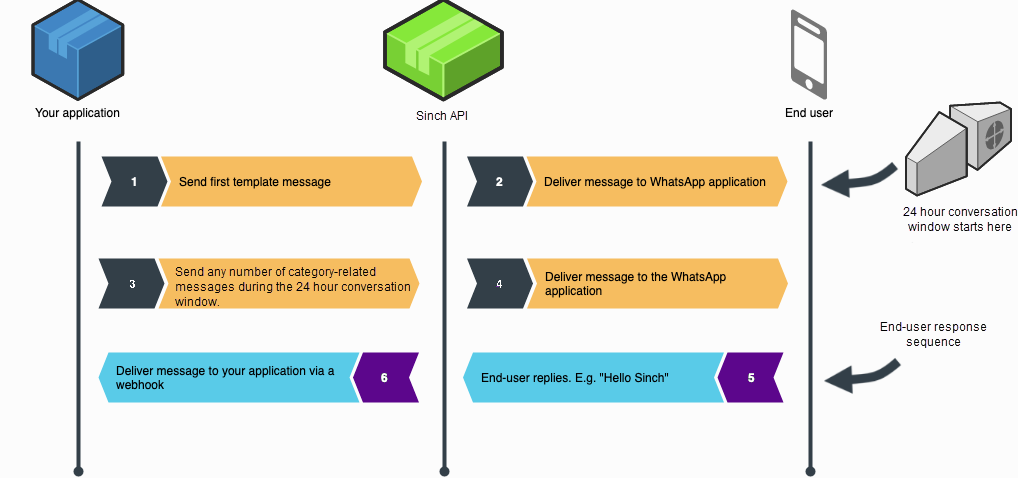Send your first WhatsApp message
To help take some of the burden away when sending messages, Sinch provisions and manages the required cloud compute, storage and database environments of WhatsApp Business, while offering high availability and throughput. This API is the first of many planned channels in our Multichannel Messaging API suite, so watch this space!
To help you evaluate our WhatsApp Business beta API, we’ve created a sandbox environment which enables you to send messages to your phone.
Preparation
- Sign-up with Sinch here to get an account if you don’t already have one.
- Send the word “tutorial” via SMS, to +13253059420 for US, or +447537453580 for UK and follow the instructions.
About WhatsApp setup and templates
Sending your first message to WhatsApp Business is like provisioning a US Short Code, but in some ways it’s stricter.
If you reach out to your customer first, you’ll need to choose a defined message template from one of 10 categories. There is no limit to the number of templates you can submit, but approvals take up to 72 hours. In this tutorial you’ll be using a pre-made bot that’s had templates approved already, so you can start right way.
WhatsApp message flow

- Customer opt-in is essential before sending any messages. In our sandbox environment you can only opt in on your phone, so in this tutorial just follow the instructions in the SMS messages you receive to enroll. Note that, as of June 30th, 2022, the Sinch WhatsApp Business Messaging API does not check whether recipients have opted in before sending messages. It is the user's responsibility to ensure that the recipient has opted in before sending.
- Businesses can only start a conversation with a defined message template.
- Once you send your first message to your customer, a “conversation” starts. You can then send conversation-rich content messages for 24 hours.
- If a conversation expires, you’ll need to re-initiate a conversation, starting with a defined message template again.
- Customers can start a rich content conversation with a business at any time - this opens up a new 24-hour session.
Right, that’s all the boring stuff out of the way, lets send some messages!
The code
1. Opt-in
As of June 30th, 2022, the Sinch WhatsApp Business Messaging API does not check whether recipients have opted in before sending messages. It is the user's responsibility to ensure that the recipient has opted in before sending. The endpoints still function, but will not be used to allow or prevent message delivery. For more information on the opt-in and opt-out requirements for WhatsApp messages, see the WhatsApp Business Policy.
Note
- In our sandbox environment, we use WhatsApp to provision a key for you. With our sandbox app you can only send messages to your phone.
- If you haven't already done so, send the word “tutorial” via SMS, to +13253059420 for US, or +447537453580 for UK, and follow the instructions. At the end of the opt-in process you will receive the API-key needed to send messages to WhatsApp.
2. Send a templated message to your number
Now you’re ready to start a conversation by sending a templated message, in this case it’s a simple "Hello from Sinch!"
node.js
var botId = 'your-received-bot-id';
var phoneNbr = 'your-phone-number-which-is-whatsapp-enabled';
var bearerToken = 'your-received-bearer-token';
var url = 'https://us1.whatsapp.api.sinch.com/whatsapp/v1/' + botId + '/messages';
var data = {
to: [phoneNbr],
message: {
type: 'template',
template_name: 'sinch_tutorial',
params: ['<recipient_name>']
}
};
var postReq = {
method: 'POST',
headers: {
'Authorization': 'Bearer ' + bearerToken,
'Content-Type': 'application/json'
},
body: JSON.stringify(data),
json: true
};
fetch(url, postReq)
.then(data => {
return data.json()
})
.then(res => {
console.log(res)
})
.catch(error => console.log(error));Warning
If you encounter an error: ReferenceError: fetch is not defined then you probably don't have fetch API installed.
Follow instructions below in order to fix this problem
-
Install an external module that uses fetch API, like
node-fetch
npm -i node-fetch --save - Add reference to fetch at the top of your js file
const fetch = require("node-fetch");3. Receive a reply to your message
In a real-world scenario, you’d have a web-hook setup connected to a bot framework or call center to react to any incoming messages, but for the sake of simplicity in this tutorial, reply to the message that just landed in your WhatsApp app.
4. Send a custom message to your phone
With WhatsApp there’s a few different message types, you can read more about them here.
Send a text message
node.js
var botId = 'your-received-bot-id';
var phoneNbr = 'your-phone-number-which-is-whatsapp-enabled';
var bearerToken = 'your-received-bearer-token';
var url = 'https://us1.whatsapp.api.sinch.com/whatsapp/v1/' + botId + '/messages';
var data = {
to: [phoneNbr],
message: {
type: 'text',
text: 'Greetings from Sinch'
}
};
var postReq = {
method: "POST",
headers: {
'Authorization': 'Bearer ' + bearerToken,
'Content-Type': 'application/json'
},
body: JSON.stringify(data),
json: true
};
fetch(url, postReq)
.then(data => {
return data.json()
})
.then(res => {
console.log(res)
})
.catch(error => console.log(error));Send an image message
This example shows you how to send an image. Please note that images / videos can be a maximum of 5MB in size and gif files are not supported.
node.js
var botId = 'your-received-bot-id';
var phoneNbr = 'your-phone-number-which-is-whatsapp-enabled';
var bearerToken = 'your-received-bearer-token';
var url = 'https://us1.whatsapp.api.sinch.com/whatsapp/v1/' + botId + '/messages';
var data = {
to: [phoneNbr],
message: {
type: 'image',
url: 'https://banner2.kisspng.com/20180602/ocl/kisspng-cats-and-the-internet-lolcat-rage-comic-pet-crazy-cat-5b1287743fec89.5449465715279409802619.jpg'
}
};
var postReq = {
method: "POST",
headers: {
'Authorization': 'Bearer ' + bearerToken,
'Content-Type': 'application/json'
},
body: JSON.stringify(data),
json: true
};
fetch(url, postReq)
.then(data => {
return data.json()
})
.then(res => {
console.log(res)
})
.catch(error => console.log(error));If you enjoyed this tutorial and would like to start sending messages to your customers, please email sales@sinch.com and we’ll help you set up a full business account where you’ll be able to specify more templates and receive replies.